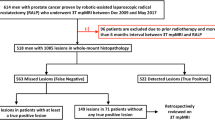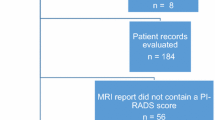Abstract
Background
Multiparametric magnetic resonance imaging (mpMRI) is increasingly used in detection and surveillance of prostate cancer. However, the co-localization of lower grade lesions between mpMRI and histopathologic specimen has not been well established.
Objective
We aim to determine the factors on final histopathological exam that correlate to tumor visibility for Grade I and II disease on mpMRI.
Methods
Fifty-five patients who underwent radical prostatectomy from July 2014 to June 2016 were analyzed for the study. Of the sample of 55 patients, 18 were found to have Gleason score (GS) of 3 + 3 or 3 + 4 disease, and then were re-reviewed and annotated by a pathologist. Lesion diameter, area, and distance from the prostate capsule were measured. The annotated lesions were co-localized to the MRI report.
Results
Of the 184 lesions identified on the whole mount histopathologic slides, 106 (57.6%), 62 (33.7%), 14 (7.6%), and 2 (1.1%) of the lesions had a GS of 3 + 3, 3 + 4, 4 + 3, and 4 + 4, respectively. On analysis, 27.3% (24/88) of GS 6 (< 1.5 cm in size), and 88.9% (16/18) of GS 6 (> 1.5 cm in size) were identified (p < 0.001). Additionally, when assessing lesion proximity to the prostatic capsule, 46.1% (41/89) of lesions closer (≤ 0.05 cm), and 30.5% (29/95) of lesions further (> 0.05 cm) from the capsule were visualized.
Conclusion
Lesion diameter, area, and capsule proximity correlated with MRI visibility. Further studies are encouraged to validate the findings of our study.



Similar content being viewed by others
References
Le JD, Tan N, Shkolyar E et al (2015) Multifocality and prostate cancer detection by multiparametric magnetic resonance imaging: correlation with whole-mount histopathology. Eur Urol 67:569–576
Russo F, Regge D, Armando E et al (2016) Detection of prostate cancer index lesions with multiparametric magnetic resonance imaging (mp-MRI) using whole-mount histological sections as the reference standard. BJU Int 118:84–94
Bratan F, Niaf E, Melodelima C et al (2013) Influence of imaging and histological factors on prostate cancer detection and localisation on multiparametric MRI: a prospective study. Eur Radiol 23:2019–2029
Becker AS, Cornelius A, Reiner CS et al (2017) Direct comparison of PI-RADS version 2 and version 1 regarding interreader agreement and diagnostic accuracy for the detection of clinically significant prostate cancer. Eur J Radiol 94:58–63
Barentsz JO, Weinreb JC, Verma S et al (2016) Synopsis of the PI-RADS v2 guidelines for multiparametric prostate magnetic resonance imaging and recommendations for use. Eur Urol 69:41–49
Weinreb JC, Barentsz JO, Choyke PL et al (2016) PI-RADS prostate imaging—reporting and data system: 2015, Version 2. Eur Urol 69:16–40
Liu W, Laitinen S, Khan S et al (2009) Copy number analysis indicates monoclonal origin of lethal metastatic prostate cancer. Nat Med 15:559–565
Turkbey B, Brown AM, Sankineni S et al (2016) Multiparametric prostate magnetic resonance imaging in the evaluation of prostate cancer. CA Cancer J Clin 66:326–336
Baco E, Ukimura O, Rud E et al (2015) Magnetic resonance imaging–transectal ultrasound image-fusion biopsies accurately characterize the index tumor: correlation with step-sectioned radical prostatectomy specimens in 135 patients. Eur Urol 67:787–794
Rud E, Klotz D, Rennesund K et al: Detection of the index tumour and tumour volume in prostate cancer using T2-weighted and diffusion-weighted magnetic resonance imaging (MRI) alone. BJU Int 114: E32–E42
Delongchamps NB, Lefèvre A, Bouazza N et al (2015) Detection of significant prostate cancer with magnetic resonance targeted biopsies—should transrectal ultrasound-magnetic resonance imaging fusion guided biopsies alone be a standard of care? J Urol 193:1198–1204
Rosenkrantz AB, Verma S, Turkbey B (2015) Prostate cancer: top places where tumors hide on multiparametric MRI. Am J Roentgenol 204:W449–W456
Rosenkrantz AB, Taneja SS (2015) Prostate MRI can reduce overdiagnosis and overtreatment of prostate cancer. Acad Radiol 22:1000–1006
Panebianco V, Barchetti F, Barentsz J et al (2015) Pitfalls in interpreting mp-MRI of the prostate: a pictorial review with pathologic correlation. Insights Imaging 6:611–630
de Gorski A, Rouprêt M, Peyronnet B et al (2015) Accuracy of magnetic resonance imaging/ultrasound fusion targeted biopsies to diagnose clinically significant prostate cancer in enlarged compared to smaller prostates. J Urol 194:669–673
Giannarini G, Crestani A, Rossanese M et al (2017) Multiparametric magnetic resonance imaging targeted biopsy for early detection of prostate cancer: All That Glitters Is Not Gold! Eur Urol 71:904–906
Walton Diaz A, Hoang AN, Turkbey B et al (2013) Can magnetic resonance-ultrasound fusion biopsy improve cancer detection in enlarged prostates? J Urol 190:2020–2025
Zhu X, Albertsen PC, Andriole GL et al (2012) Risk-based prostate cancer screening. Eur Urol 61:652–661
Briganti A, Chun FK-H, Suardi N et al (2007) Prostate volume and adverse prostate cancer features: fact not artifact. Eur J Cancer 43:2669–2677
Freedland SJ, Isaacs WB, Platz EA et al (2005) Prostate size and risk of high-grade, advanced prostate cancer and biochemical progression after radical prostatectomy: a search database study. J Clin Oncol 23:7546–7554
Chen ME, Troncoso P, Johnston D et al (1999) Prostate cancer detection: relationship to prostate size. Urology 53:764–768
Rosenkrantz AB, Lim RP, Haghighi M et al (2013) Comparison of interreader reproducibility of the prostate imaging reporting and data system and Likert scales for evaluation of multiparametric prostate MRI. Am J Roentgenol 201:W612–W618
Author information
Authors and Affiliations
Corresponding author
Electronic supplementary material
Rights and permissions
About this article
Cite this article
Wang, M., Janaki, N., Buzzy, C. et al. Whole mount histopathological correlation with prostate MRI in Grade I and II prostatectomy patients. Int Urol Nephrol 51, 425–434 (2019). https://doi.org/10.1007/s11255-019-02083-8
Received:
Accepted:
Published:
Issue Date:
DOI: https://doi.org/10.1007/s11255-019-02083-8





